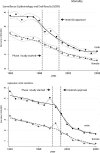Decreasing trend in mortality of chronic myelogenous leukemia patients after introduction of imatinib in Japan and the U.S
- PMID: 22971523
- PMCID: PMC3528387
- DOI: 10.1634/theoncologist.2012-0197
Decreasing trend in mortality of chronic myelogenous leukemia patients after introduction of imatinib in Japan and the U.S
Abstract
Purpose: Although the impact of imatinib in improving survival outcomes in chronic myelogenous leukemia (CML) patients has been widely reported, its impact on mortality from CML has not been evaluated. A survival benefit demonstrated in clinical trials does not simply translate to a decrease in mortality. To evaluate the impact of imatinib on the public health, we estimated the age-standardized mortality rate of CML patients in Japan and the U.S. using vital statistics data for Japan and data from the Surveillance, Epidemiology, and End Results (SEER) Program of the National Cancer Institute for the U.S.
Patients and methods: The period covered in this analysis is 1993-2008, during which 64,203 patients in Japan and 26,888 patients in nine registries in the U.S. died as a result of CML. We used joinpoint regression analysis to evaluate the significance of trends in mortality.
Results: Estimated age-standardized mortality rates decreased significantly in both countries after the availability of imatinib. The annual percent changes (95% confidence interval) in the U.S. were -12.3% (-14.8% to -9.7%) for men and -11.6% (-13.1% to -10.1%) for women. In Japan, these were -20.8% (-36.2% to -1.6%) for men and -15.6% (-18.8% to -12.2%) for women. The period of change in the mortality trend seems to correlate with the period in which imatinib appeared in the two countries. The CML mortality rate in 2008 was nearly 30% that of the 1993 level.
Conclusion: This is one example of the advent of a single new drug changing the picture of a single disease, CML. These results may encourage further development of drugs based on the concept of molecular targeting.
Conflict of interest statement
Figures

References
-
- Mangano DT, Rieves RD, Weiss KD. Aspirin and mortality from coronary bypass surgery. N Engl J Med. 2002;347:1309–1317. - PubMed
-
- Bartram CR, de Klein A, Hagemeijer A, et al. Translocation of c-ab1 oncogene correlates with the presence of a Philadelphia chromosome in chronic myelocytic leukaemia. Nature. 1983;306:277–280. - PubMed
-
- Sant M, Allemani C, Tereanu C, et al. HAEMACARE Working Group. Incidence of hematologic malignancies in Europe by morphologic subtype: Results of the HAEMACARE project. Blood. 2010;116:3724–3734. - PubMed
Publication types
MeSH terms
Substances
LinkOut - more resources
Full Text Sources
Medical

